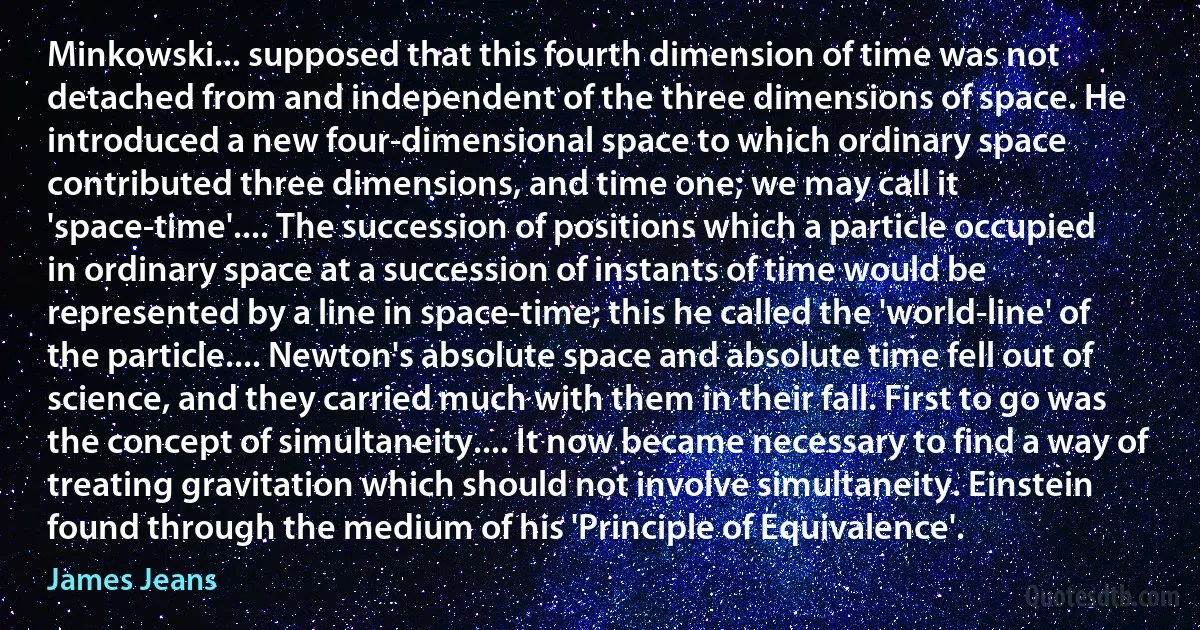
Minkowski... supposed that this fourth dimension of time was not detached from and independent of the three dimensions of space. He introduced a new four-dimensional space to which ordinary space contributed three dimensions, and time one; we may call it 'space-time'.... The succession of positions which a particle occupied in ordinary space at a succession of instants of time would be represented by a line in space-time; this he called the 'world-line' of the particle.... Newton's absolute space and absolute time fell out of science, and they carried much with them in their fall. First to go was the concept of simultaneity.... It now became necessary to find a way of treating gravitation which should not involve simultaneity. Einstein found through the medium of his 'Principle of Equivalence'.
James JeansRelated topics
call carry concept dimension equivalence fell fall found find gravitation line necessary now science should simultaneity space three time treating way einstein space-timeRelated quotes
On the evening of the 29th, the army fell back to the north end of the Island. The next morning, the enemy advanced upon us in two columns upon the east and west road. Our light troops, commanded by Colonel Livingston and Colonel Laurens, attacked the heads of the columns about seven o'clock in the morning, but were beat back they were reinforced with a regiment upon each road. The enemy still proved too strong. General Sullivan formed the army in order of battle, and resolved to wait their approach upon the ground we were encamped on, and sent orders to the light troops to fall back. The enemy came up and formed upon Quaker Hill, a very strong piece of ground, within about one mile and a quarter of our line. We were well posted, with strong works in our rear, and a strong redoubt in front, partly upon the right of the line.

Nathanael Greene
Every measurable thing except numbers is imagined in the manner of a continuous quantity. Therefore, for the mensuration of such a thing, it is necessary that points, lines, and surfaces, or their properties, be imagined. For in them... measure or ratio is initially found... Therefore, every intensity which can be acquired successively ought to be imagined by a straight line perpendicularly erected on some point of the space or subject of the intensible thing, e. g., a quality... And since the quantity or ratio of lines is better known and is more readily conceived by us-nay the line is in the first species of continua, therefore such intensity ought to be imagined by lines... Therefore, equal intensities are designated by equal lines, a double intensity by a double line, and always in the same way if one proceeds proportionally.

Nicole Oresme
Classical science was based upon the belief that it is possible to formulate both the position and velocity at one time of any given particle. It followed that knowledge of the position and velocity of a given number of particles would enable the future behavior of the whole collection to be accurately predicted. The principle of Heisenberg is that given the determination of position, its velocity can be stated only as of a certain order of probability, while if its velocity is determined the correlative factor of position can be stated only as of a certain order of probability. Both cannot be determined at once, from which it follows necessarily that the future of the whole collection cannot possibly be foretold except in terms of some order of probability.

John Dewey
A line cannot control pictorial space absolutely. A line may flow freely in and out space, but cannot independently create the phenomenon of push and pull necessary to plastic creation. Push and pull are expanding and contracting forces which are activated by carriers in visual motion. Planes are the most important carriers, lines and points less so.. .the picture plane reacts automatically in the opposite direction to the stimulus received; thus action continues as long as it receives stimulus in the creative process. Push answers with pull and pull with push. ... At the end of his life and the height of his capacity Cézanne understood color as a force of push and pull. In his pictures he created an enormous sense of volume, breathing, pulsating, expanding, contracting through his use of colors.

Hans Hofmann
On the 15th of April 1744, I described the principle upon which the following work is based, in the public assembly of the Royal Academy of Sciences of Paris, as reported in the Acts of that academy.
At the end of the same year, Professor Euler published his excellent book Methodus inveniendi lineas curvas maximi minimive proprietate gaudentes. In a supplement to his book, this illustrious geometer showed that, in the trajectory of a particle acted on by a central force, the velocity multiplied by the line element of the trajectory is minimized.
This observation gave me great pleasure, as a beautiful application of my principle to the motion of the planets, which is determined by this principle.
From the same principle, I will now try to derive higher and more important truths.

Pierre Louis Maupertuis
